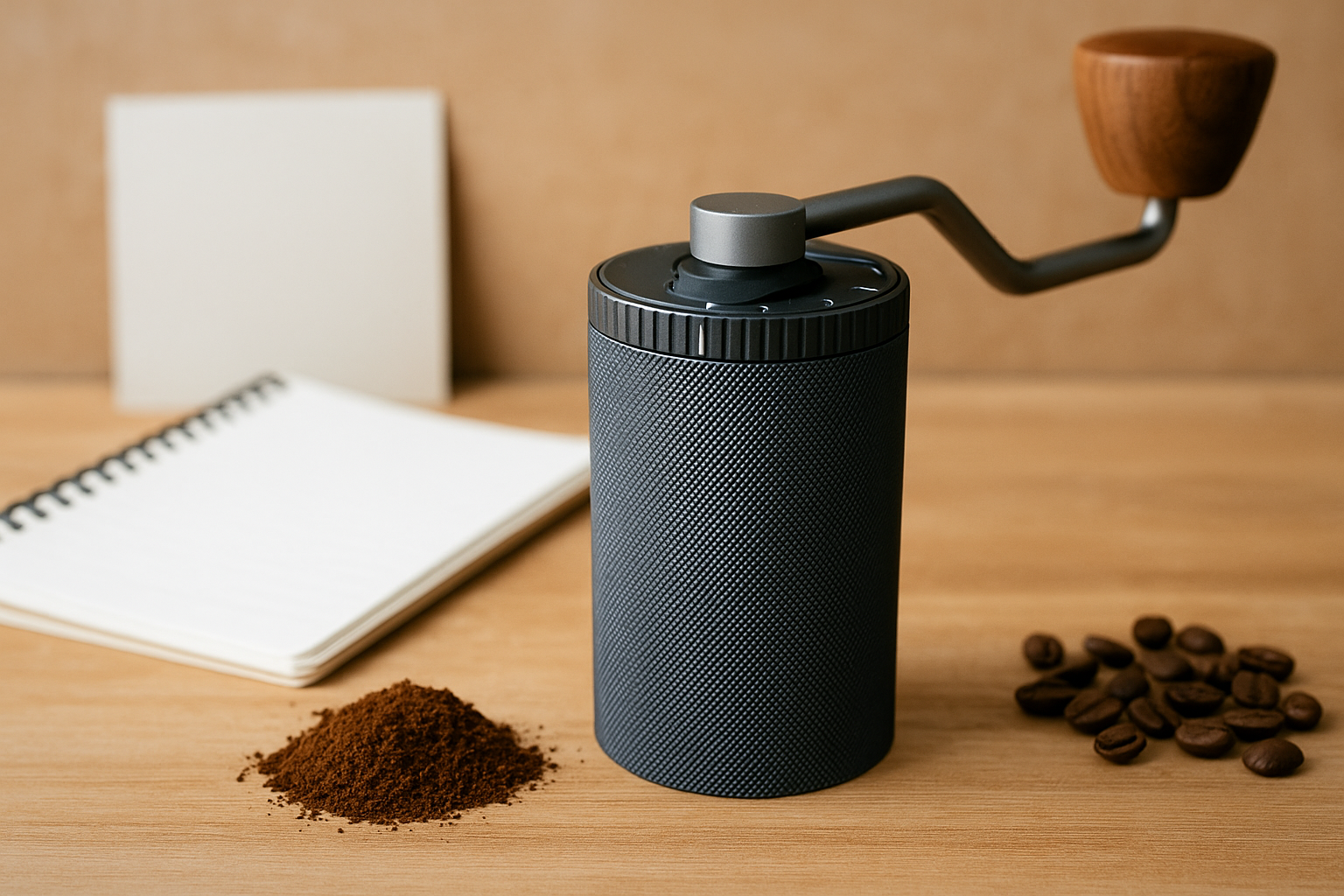If you’ve ever brewed coffee that tasted too sour, too bitter, or just… off, there’s a good chance your grind size is to blame.
While water temperature, brew time, and coffee-to-water ratio are all important, grind size is often the most critical—and most overlooked—factor in brewing coffee at home. Mastering it can transform an average cup into something exceptional.
In this comprehensive guide, you’ll learn how grind size affects flavor, how to adjust it for different brewing methods, how to troubleshoot bad coffee by tweaking your grind, and why even tiny changes in grind consistency can make a big impact on taste.
Why Grind Size Matters So Much
Brewing coffee is a process of extraction—the act of drawing soluble compounds (like acids, sugars, oils, and aromatics) out of ground coffee and into water. Your grind size determines the surface area that the water interacts with during this process.
- Fine grinds extract faster because there’s more surface area.
- Coarse grinds extract more slowly due to larger particles and less contact area.
If your grind size doesn’t match your brewing method—or if it’s inconsistent—you’ll end up with an under- or over-extracted cup.
Under-Extraction vs. Over-Extraction: What’s the Difference?
Understanding extraction helps you fix flavor problems by adjusting your grind.
Under-Extracted Coffee (Grind too coarse)
- Tastes: Sour, acidic, sharp, salty
- Cause: Water didn’t spend enough time with the coffee grounds, so only the most soluble (acidic) compounds made it into the cup
Over-Extracted Coffee (Grind too fine)
- Tastes: Bitter, dry, burnt, astringent
- Cause: Water stayed too long in contact with grounds, pulling out bitter and undesirable flavors
The sweet spot lies in between: balanced, sweet, full-bodied coffee that highlights the origin and roast.
Matching Grind Size to Brewing Method
Each brewing method has an ideal grind size. Here’s a quick reference:
| Brewing Method | Ideal Grind Size | Texture |
|---|---|---|
| Cold Brew | Extra coarse | Rock salt |
| French Press | Coarse | Kosher salt |
| Chemex | Medium-coarse | Rough sand |
| Drip Machine | Medium | Regular sand |
| Pour-Over (V60) | Medium-fine | Table salt |
| AeroPress | Medium-fine to fine | Sugar or flour |
| Moka Pot | Fine | Slightly coarser than espresso |
| Espresso | Very fine | Powdered sugar |
| Turkish Coffee | Extra fine | Flour |
Note: Your grinder may not label grind size by brew method. Start with a visual guide or manufacturer recommendation, then tweak based on taste.
The Role of Consistency: Why Burr Grinders Are Better
Even if your grind size is technically correct, inconsistency kills flavor. Blade grinders chop beans unevenly, resulting in a mix of fine powder and coarse chunks. The result? Some grounds are over-extracted, while others are under-extracted—all in the same cup.
Burr Grinders (manual or electric):
- Crush beans between two burrs for uniform particle size
- Offer micro-adjustments for fine-tuning
- Deliver repeatable results
Recommended Budget Burr Grinders:
- Manual: Timemore C2, 1Zpresso JX
- Electric: Baratza Encore, Fellow Ode Gen 2
How to Dial In Your Grind: Step-by-Step
Whether you’re using a pour-over, AeroPress, or espresso machine, dialing in your grind is a key part of getting the flavor just right.
Step 1: Brew Your Coffee
Use your regular method, a scale, and a timer. Note the:
- Taste
- Brew time
- Strength and clarity
Step 2: Taste and Evaluate
- Sour or sharp? Grind finer.
- Bitter or dry? Grind coarser.
- Weak or watery? Check your dose and grind finer.
- Strong but muddy? Grind slightly coarser and reduce dose.
Step 3: Adjust and Brew Again
Make small adjustments—just one or two clicks on your grinder at a time. Too many changes at once can confuse the process.
Step 4: Record Your Results
Keep a simple journal with notes on:
- Grind setting
- Brew time
- Ratio
- Taste impressions
This helps you build a profile and avoid repeating mistakes.
Espresso: Where Grind Size Is Crucial
In espresso, tiny changes in grind size make a massive difference. That’s because the contact time is only 25–30 seconds and the pressure is high (around 9 bars). A slight misstep can ruin your shot.
How to know your espresso grind is off:
- Shot pulls in under 20 seconds = grind is too coarse
- Shot takes 40+ seconds = grind is too fine
Aim for:
- 18g in → 36–40g out in 25–30 seconds
- Adjust grind if it’s outside that range
Tip: Always adjust grind first before changing dose or time.
Pour-Over and Grind: Unlocking Clarity
With pour-over methods like the V60 or Chemex, grind size affects:
- Flow rate
- Brew time
- Clarity of flavor
- Perceived acidity
Start with medium-fine grind and shoot for a 2.5 to 3.5 minute brew. If the coffee tastes:
- Sour or underwhelming: Grind finer
- Bitter or dry: Grind coarser
Use a gooseneck kettle for better pour control and consistency.
Troubleshooting Grind Problems
| Problem | Likely Cause | Fix |
|---|---|---|
| Coffee tastes sour or salty | Under-extracted | Grind finer |
| Coffee tastes bitter or burnt | Over-extracted | Grind coarser |
| Brew is too fast | Grind too coarse | Grind finer |
| Brew is too slow | Grind too fine or choked | Grind coarser |
| Weak, thin coffee | Too coarse or not enough coffee | Increase dose or grind finer |
Adjusting Grind for Different Beans
Even with the same method, different beans may require different grind settings.
Light Roasts:
- Denser and need more contact time
- Use finer grind
Dark Roasts:
- Softer and extract more quickly
- Use coarser grind
Taste is always the final judge—adjust as needed with each new bag.
Tools to Help You Perfect Grind Size
- Grind size reference cards or posters
- Grind distribution trays (for comparing particle sizes)
- Sifter kits (for super-geeky consistency analysis)
- Espresso puck screen (for better water dispersion at fine grinds)
While not necessary for most home brewers, these tools can help if you want to go deeper into coffee science.
Grind Size and Water Flow: A Direct Relationship
Remember: water flows faster through coarse grinds and slower through fine ones.
If your brew time is too short or too long:
- Too short: Water is rushing through; grind finer to increase resistance.
- Too long: Water is stalling; grind coarser to speed things up.
Brewing coffee is like plumbing—grind controls the flow.
Grind Size and Body: What to Expect
The grind size doesn’t just affect strength—it also changes the texture of your coffee.
| Grind Size | Body in Cup |
|---|---|
| Coarse | Thin, light, tea-like |
| Medium | Balanced, smooth |
| Fine | Full, syrupy |
If you like bold, heavy-bodied coffee, go finer. If you like clean, crisp cups, go coarser and filter well.
Final Thoughts: Your Grind Is Your Foundation
You can’t fix a bad grind with better water or technique. Getting your grind size right is the foundation of great coffee. It’s what separates okay cups from exceptional ones—and the best part? It’s totally within your control.
Buy a burr grinder, learn your method’s ideal grind range, and practice small adjustments. Taste, tweak, and repeat. Once you nail it, every cup will taste the way your coffee should—sweet, complex, and satisfying.

Marcelo Oliveira is a coffee enthusiast and content creator specializing in barista skills, brewing methods, equipment reviews, coffee-related health insights, and fascinating curiosities from the coffee world. With a deep passion for every step of the brewing process, he turns technical knowledge into accessible and engaging content for both beginners and seasoned coffee lovers. Marcelo’s goal is to help readers appreciate the full experience of coffee—from bean to cup.
